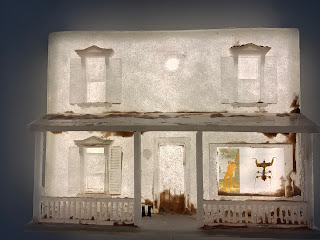Captivating 3D Works at Art Basel
 |
| "Chinese Looking in Round Mirror" by Juan Munoz (1999) |
Munoz is known for his realistic figures installed in public places. Many of his works -- like this one -- feature Chinese figures, often in groups. In an exhibit at the Tate Museum in London, one gallery featured 100 figures similar to the one shown here. What fun it would have been to romp in the midst of that crowd! Or so I thought until I read a review of the exhibit in The Guardian that noted, "As soon as you appear among them, you will simultaneously feel excluded, left out of the party or the secret or whatever the private joke might be." Hmm.
Biographer Paul Schimmel commented in an interview with Munoz, "Many of your figures tend towards the exotic—dwarves, aliens, puppets, ballerinas, actors, Chinese figures. As the spectator, we are looking at the Other. We do not see ourselves." Munoz confirmed this interpretation, saying, "My characters sometimes behave as a mirror that cannot reflect. They are there to tell you something about your looking, but they cannot, because they don't let you see yourself." When an actual mirror is added to the work so you can see yourself looking at a character in which you can't see yourself, this concept becomes kind of mind blowing. And here I was just enjoying an opportunity for a selfie.
 |
| "Emperor Penguin" by Mark Dion (2016) |
Like Munoz' work, there's a serious message in this sculpture. Of course, everyone loves a penguin, so you have to smile when you first see it. But why is it placed in a tub? And why is the tub filled with jewelry and tar? The answer: "Emperor Penguin" is reminding us of the price of global warming.
"Emperor Penguin" has been making the rounds. When on view at Galerie Heike Strelow in Frankfurt, its description read, in part, "The dummy of an empire penguin sits in a zinc tub as though freshly imported from Antarctica and only just unpacked. Whether the tub offers protection for survival in the face of melting Antarctic ice is questionable. Dion takes his sculpture off its pedestal and places it on the same crate that serves to transport it. In this way, he ultimately also criticizes the business of art, which contributes to climate change through global trade and exhibitions." So now we know why the penguin is on a crate. Like Cattelan, Dion is providing some negative commentary on shows like Art Basel. A cynic might question why their work is on display there.
 |
| By Sula Bermudez-Silverman |
There's not much information out there about about Bermudez-Silverman. That's not overly surprising given that she's only 28 years old. In an interview about her work on display at the California African American Museum, Bermudez-Silverman explained that the idea of using sugar as a material derived from her ancestors' work on sugar cane plantations in Puerto Rico. The houses themselves are reminders of her own doll house as a child. To hear the artist talk about her art, click here.
 |
| "Softlining" by Jesse Wine (2021) |
The scene was set by Wine himself, whose goal was to challenge the "white cube" of much art viewing. Wine also sought to "probe the theatricality of art viewing." Mission accomplished. But even without the unique setting, "Softlining" is a sculpture that would stand out in a crowd. Is anyone else having flashbacks to their youth?
It turns out that Wine's sculptures often feature limbs. In an interview with Mousse Magazine (?), Wine talks about this choice, saying, "There is a whole world of emotion manifested in every limb. Limbs are almost more successful places to communicate emotions than faces, because you can have an expression on the face, but the posture of a limb could undermine that. I feel that controlling the emotions of one’s limbs is much more difficult than controlling the emotions on one’s face. As if the limb might double-cross its owner." I love that explanation. To read the interview in its entirety, click here. And to see the exhibit discussed, click here.
I could go on and on. It's just so much fun to delve into works that I had so little time to appreciate in person. But I had to slice and dice the great art I saw in some way and there are paintings to be shared. I hope you'll stay tuned.
